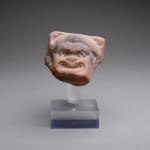Greco-Roman Terracotta Sculpture of a Theatrical Mask, 200 BCE - 100 CE
Terracotta
8.3 x 8.9 cm
3 1/4 x 3 1/2 in
3 1/4 x 3 1/2 in
P.4453
Further images
Since the dawn of time, man has offered votives to win the benign favour of his gods. Sometimes these were perishable gifts of food, or wine, or livestock. At other...
Since the dawn of time, man has offered votives to win the benign favour of his gods. Sometimes these were perishable gifts of food, or wine, or livestock. At other times they were figures of stone, metal or clay--votives of a more enduring nature. The art of the sculpted clay votive reached its peak in the Hellenistic age, when the artistic influence of Classical Greece spread throughout the Mediterranean and Near East.
Images of theatre masks, both comic and tragic, are discovered right across the Hellenistic world and the Roman Empire, and in places not necessarily connected to the theatre. They appear on mosaic floors, as frescoed decoration on walls, or (as in this case) as protomes and oscilla which were even sometimes suspended from buildings and moved when caught by the breeze (hence oscillate!). These mask refer to the god Dionysus, patron of the theater and god of rebirth. Terracotta theater masks are found in burials and sanctuaries in Greece, in sanctuaries and as garden decorations in Italy. In Egypt, they are known only from burials, as offerings to Osiris/Dionysus. In this case we are looking at a mask of a comedian, a comic figure distinguished by a broad grin.
This is a remarkably interesting artefact, of great decorative value.
Images of theatre masks, both comic and tragic, are discovered right across the Hellenistic world and the Roman Empire, and in places not necessarily connected to the theatre. They appear on mosaic floors, as frescoed decoration on walls, or (as in this case) as protomes and oscilla which were even sometimes suspended from buildings and moved when caught by the breeze (hence oscillate!). These mask refer to the god Dionysus, patron of the theater and god of rebirth. Terracotta theater masks are found in burials and sanctuaries in Greece, in sanctuaries and as garden decorations in Italy. In Egypt, they are known only from burials, as offerings to Osiris/Dionysus. In this case we are looking at a mask of a comedian, a comic figure distinguished by a broad grin.
This is a remarkably interesting artefact, of great decorative value.
Literature
V1







